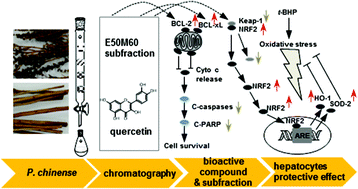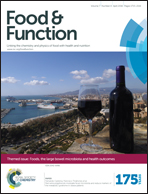Bio-assay guided identification of hepatoprotective polyphenols from Penthorum chinense Pursh on t-BHP induced oxidative stress injured L02 cells†
Abstract
Penthorum chinense Pursh (Ganhuangcao in Chinese) is traditionally used for liver protection and treatment of liver diseases, including hepatitis B, hepatitis C and alcoholic liver damage. We and others have disclosed the hepatoprotective effect of different extracts from P. chinense. To further explore the chemical principles responsible for its liver protective effect, a bioactivity guided isolation was carried out on the water extract of P. chinense, which led to the identification of an effective fraction (E50M60). Further isolation of the E50M60 fraction produced ten polyphenols. Among them, quercetin showed the most significant protective effect on tert-butyl hydroperoxide (t-BHP) induced hepatocyte damage. Further study demonstrated that both the E50M60 fraction and quercetin attenuated t-BHP induced hepatocyte apoptosis through up-regulating the expression of B-cell lymphoma-2 protein (BCL-2) and BCL-xL, and down-regulating the cleaved products of caspase-7, -9 and nuclear poly(ADP-ribose) polymerase (PARP). Moreover, the E50M60 fraction and quercetin promoted nuclear factor-like 2 (NRF2), superoxide dismutase-2 (SOD-2) and heme oxygenase-1 (HO-1) expressions and suppressed Kelch-like ECH-associated protein 1 (KEAP-1) expression, resulting in resistance to the reactive oxygen species (ROS) induced mitochondrial oxidative stress. Altogether, both the active fraction and quercetin from P. chinense might be well developed as a novel functional food for liver protection.


 Please wait while we load your content...
Please wait while we load your content...